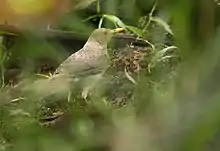Ecuadorian thrush
The Ecuadorian thrush (Turdus maculirostris) is a resident bird found in western South America in western Ecuador and far northwestern Peru. It was formerly considered to be a subspecies of the spectacled thrush (yellow-eyed thrush), Turdus nudigenis, but has a narrower eyering, and is widely separated in range.
| Ecuadorian thrush | |
|---|---|
 | |
| Scientific classification | |
| Kingdom: | Animalia |
| Phylum: | Chordata |
| Class: | Aves |
| Order: | Passeriformes |
| Family: | Turdidae |
| Genus: | Turdus |
| Species: | T. maculirostris |
| Binomial name | |
| Turdus maculirostris Berlepsch & Taczanowski 1883 | |
| Synonyms | |
|
Turdus nudigenis maculirostris | |
The habitat of this thrush is woodland, and forest edges and clearings, up to 2000 metres.
Description
The Ecuadorian thrush is 21.5 – 23 cm long. It is plain olive-brown above (paler than bare-eyed) and a paler brown below. The throat is brown-streaked off-white, and the lower belly is whitish. It has a narrow yellow eye ring. Sexes are similar, but young birds are flecked above and spotted below. There are no subspecies.
Behaviour
The nest is a lined bulky cup of twigs low in a tree. The only known clutch was of three reddish-blotched blue eggs.
The Ecuadorian thrush feeds in trees on fruit, berries and some insects and earthworms. It is a shy species, and may be largely crepuscular. It is normally alone or in pairs, but may congregate in fruiting trees, often with plumbeous-backed thrush.
References
- BirdLife International (2012). "Turdus maculirostris". IUCN Red List of Threatened Species. 2012. Retrieved 26 November 2013.CS1 maint: ref=harv (link)
- Clement and Hathaway Thrushes ISBN 0-7136-3940-7
